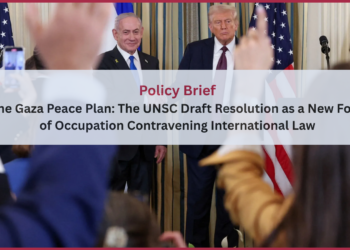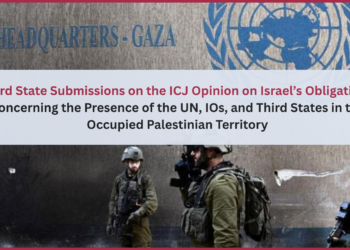Book Review: The obsession with the wall : The politics of borders’ militarization in the United States and Israel , by Damien Simonneau *. Brussels: Peter Lang, 2020. 420 pages. In French.
By: Ahmad al-Austath.
For: Law for Palestine
In addition to seven chapters, this valuable book includes an introduction, “The border-walls from the perspective of the political scene”, and a conclusion, “The military face of our societies”. The titles of the chapters are as follows:
Chapter one, “Border-walls from the perspective of the pro-border-walls mobilization movements: a comparison based on theoretical and methodological grounds”;
Chapter two, “Fears and crisis on adjacent/contact points”;
Chapter three, “Narrating the stories of the pro-border-walls idea”;
Chapter four, “The walls and militarization”;
Chapter five, “Problematic issues on the walls question”;
Chapter six, “The procedures fostering the walls idea; and
Chapter seven, “The allegations of the pro-wall idea groups vis-à-vis their governments”.
In his book, Simonneau deals with the increasing number of countries that would like to reinforce its borders by establishing military walls whose efficiency has become under debate. To explain this obsession/mania, Simonneau pinpoints the arguments that are given to reduce the negative impacts of those military tools, through his discussion of two contemporary examples of borders’ security: the Israeli-security wall in the West Bank and the border wall between the United States and Mexico.
Simonneau envisions the border-walls as part of the political field that is directed towards the citizens who live behind them; as these walls guarantee for those citizens mitigating the internal political tensions, resulting from the mobility and immigration to their societies. Border-walls also guarantee for those citizens the management of their societies’ essential problems regarding security, the economy and work opportunities. Based on this analysis, the author attributes the making of this political field to the conservatives, security-oriented and those hostile to foreigners. This is through these conservatives’ provocation of the problems related to the mobility movement, their developing security expertise to limit this movement, and through pressuring their governments to take more efficient actions against this mobility.
The author based his book on two exploratory studies that used interviews and field-observations and analyzed the archives of the pro-wall mobilization movements in order to track the views of those considered pro-border-walls politics. The author presented and compared the narratives of those who argue for the necessity of establishing these walls, and he highlighted the procedures they used to pressure their governments.
Through these two studies, Simonneau intended to go beyond the idea that the establishment of the border-walls is only an indication of the deterioration of state hegemony in a world in which globalization and open borders prevail. Rather, he wanted to clearly assert that the disadvantages of the political scenes, resulting from the border-walls policies, are not only restricted to the state’s isolation, but that they also include reinforcing the militarization of societies on the expense of the human, the legal or the economic strategies pertinent to dealing with mobility across borders.
As for the Palestinian-Israeli part of the study, Simonneau considers the Israeli actions, resulting from the security Israeli wall in the West Bank, a violation of the international law, as stated in Security Council resolution no. 2334, issued on December 23, 2016. He argues that, for the wall, there are other dimensions than the security consideration, which is based on monitoring Palestinians’ mobility and on categorizing Palestinian communities. These other dimensions include the political and the social issues in the Israeli society which provoke the ill will of the conservatives and the security-oriented, that they are pushed to participate in the making of the militarization politics of the wall.
For example, the author observes that the wall – established in 2002 to prevent the Palestinian military operations such as these which occurred in the 1980s and 1990s of the previous century – has later become one with a political dimension that aims at reinforcing the separation from any possible independent Palestinian political entity, represented by the Palestinian Authority (PA). The wall has thus paved the way for Israel to continue its exploitation of the Palestinian resources in the West Bank, while entrusting the PA with the responsibility of administrating Palestinians’ everyday life.
In this respect, Simonneau also points that the Israelis see in this wall – which separates them from the Palestinians – a means to complete their settlement project, because, for them, today’s temporary borders, marked by this wall, will later become tomorrow’s permanent and stable borders.
As for the social dimension, Simonneau tracks the views of the pro-wall idea among the Israelis, who perceive the demographic growth of Palestinians as a threat to their Israeli national identity, and therefore believe that the wall is an effective means to curb this threat. As for the Palestinians, Simonneau observes that, the wall for them is but another additional constituent of the Israeli occupation, which dissipates their dream of an independent Palestinian state.
Finally, because the book is based on two contemporary examples of military walls and clearly deals with the political and security issues pertinent to establishing the walls and relates those issues to legal, social and human impacts, in addition to dealing with settlement aspiration – the most vital among these, we believe that this book is important for researchers in the political and social sciences, international law and international security and defense.
—
* Damien Simonneau obtained his PhD in political science from the University of Bordeaux in France. Currently, he is a lecturer of international relations at Saint Louis University in Brussels. In light of the militarization of borders, his research focuses on comparing the politics of contemporary borders’ security in the United States of America, Israel and Europe, as well as on issues of immigration, mobility and the economic interests related to them.





